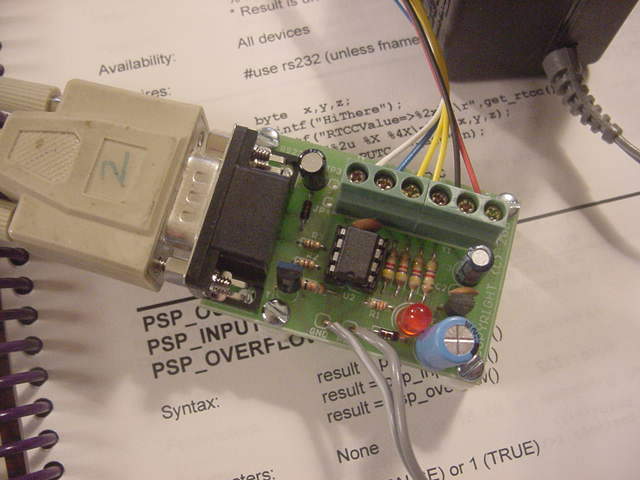Reduce Scrapping and Smelting, Promote Component Reuse > Complete Machines
> 1980 2000
> Tm #128 serial dallas 1-w measurement module
Tm #128 serial dallas 1-w measurement module
The TM #128 is an assembled unit which interfaces with a PC COM port to perform measurements on any mix of Dallas DS18S20 and DS18B20 (DS1822) temperature sensors, DS2438 temperature and 10-bit A/D converters, DS2450 Qaud A/D converters and DS2423 Dual 32-bit counters on each of two twisted pair runs. Up to sixteen devices with a maximum of 200 feet of twisted pair cable may be accommodated on each of the two runs. In addition, a single TTL input is provided.
The package includes an assembled printed circuit board, a nominal 12 VDC wall power unit, a six foot serial cable (DB9) and a single DS18S20.
Additional DS18S20 and DS18B20 temperature sensors, DS2438Z temperature and A/D sensors, DS2450 quad A/D converters and DS2423 dual counters may be purchased separately.
The PCB is professionally fabricated.
The module includes a female DB9 connector, RS232 level shift circuitry, an on-board 5 VDC supply, a Microchip PIC processor and a six conductor screw type terminal block. There are three holes on the PCB to permit the user to mount the module in a box or on a plate. Three one-half inch spacers and associated 4-40 pan head screws are provided.
A PC or similar interfaces with the TM #128 module using 9600 baud, 8-bits, no Parity, either 1 or 2 stop bits, no flow control. Only the TX, RX and GRD leads are used. Note that a USB to RS232 serial converter may be used if you do not have a conventional COM Port.
Note that up to 16 Dallas 1-wire devices in any combination may be accommodated on each of two twisted pair runs. Thus, on one run, one might have eight temperature sensors, a DS2450 quad A/D and a DS2438 temperature sensor and A/D. On the second run, one might have several additional temperature sensors and perhaps two DS2423 dual counters.
On receipt of any character, the TM #128 performs a measurement sequence, beginning with the status of the TTL input and then finds each device on each of the two Dallas runs and performs the appropriate measurements. For example;
00 20 29AE 3.862 0.062 0.060 0.061
06 1D C827 00000000 00000000
10 20 C9AE 3.781 0.065 0.066 0.066
16 1D C827 00000003 0000001C
In the above, the state of the TTL input is a logic zero.
On Run 0 (first digit) the processor found a DS2450 (code 20), two DS18S20s (code 10) and one DS18B20 (code 28) and one DS1822 (code 22), one DS2438 (code 26) and one DS2423 (code 1D). The device code is followed by a 16-bit serial number expressed in hexadecimal. For the DS2450, note the four voltages, for the DS18S20, DS18B20 and DS1822, note the temperatures in degrees C, for the DS2438, note the temperature followed by the two voltages and for the DS2423, note the values of the two 32-bit counters in hexadecimal.
On Run 1, the processor found another DS2450 (code 20) a DS18S20 (code 10), a DS2438 (code 26) and another DS2423 dual counter (code 1D).
Note as each device is found, it is assigned an identity consisting of the run (0 or 1) and a sequential number in the range of 0 - F. This sequential number is simply a running number which is assigned as each device is found.
The second field identifies the type of device; DS18S20 - Code 10, DS1822 - Code 22, DS18B20 - Code 28, DS2438 - Code 26, DS2423 - Code 1D, DS2450 - Code 20. Field three is a unique 16-bit identifier for the device. Note that the actual Dallas ID consists of 48-bits and in the above, only 16 are being used. However, the sixteen bits provides for 65,535 combinations and I seriously doubt anyone will find a duplication in their system.
